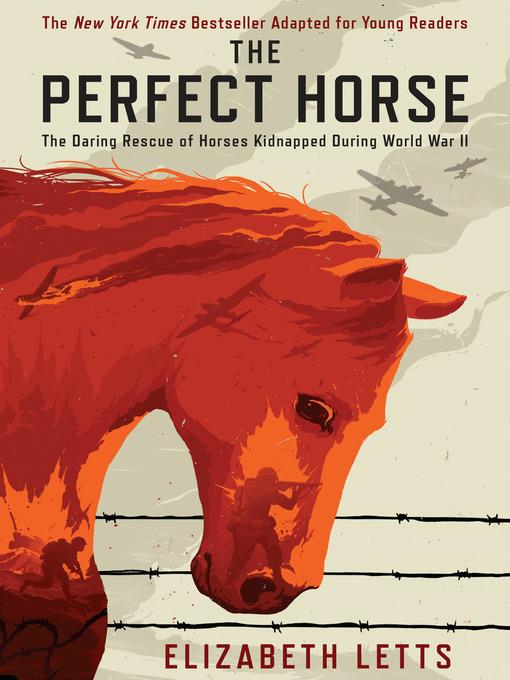
The Perfect Horse
The Daring Rescue of Horses Kidnapped During World War II
فرمت کتاب
ebook
تاریخ انتشار
2019
Lexile Score
1080
Reading Level
7-9
ATOS
8.2
Interest Level
4-8(MG)
نویسنده
Elizabeth Lettsشابک
9780525644750
کتاب های مرتبط
- اطلاعات
- نقد و بررسی
- دیدگاه کاربران
نقد و بررسی

November 1, 2018
Letts adapts her bestselling 2016 work of the same title for young readers.As World War II sweeps across Europe, the fates of several master horsemen become entwined. In Poland, Andrzej Kristalovich, head of the national stud farm, sees his life's work disappear when Russian soldiers capture his horses. Nazi Germans, invading next, restore some of the animals in order to breed them for the Third Reich. Meanwhile, in Vienna, Olympic medalist Alois Podhajsky is desperately trying to care for the Lipizzan stallions at the famed Spanish Riding School even as the invading Germans capture the Lipizzan stud farms and move most of the horses to Czechoslovakia. Meanwhile, at an American Army base in Kansas, Maj. Hank Reed is overseeing the cavalry's transition from horses, no longer useful in warfare, to mechanized vehicles. These threads come together at the end of the war when Reed orchestrates a complex rescue of both sets of horses. This is not a particularly successful adaptation. It's shorter than the original, but both the storyline and timeline are fragmented, making it difficult for the putative audience of 8- to 12-year-olds to follow, and extraneous details fail to advance the main narrative. Aside from a map and archival images (both not seen), there is no timeline or other visual aid to help organize the narrative. Characters are all white.If readers can make sense of this story, they're likely able to tackle the original instead. (author's note, characters, bibliography) (Nonfiction. 10-14)
COPYRIGHT(2018) Kirkus Reviews, ALL RIGHTS RESERVED.

Gr 7 Up-This adaptation of Letts's best-selling work about the rescue of purebred horses highlights a little-known aspect of World War II. The book traces the movements of various groups of horses and their caretakers, often through dangerous circumstances. These animals, once bred for Austrian and Polish kings, became part of German eugenics experiments to breed the perfect warhorse. In a climactic scene, U.S. troops, at the request of the horses' caretakers and under orders from General Patton, cross enemy lines to rescue a group of horses from a farm in Czechoslovakia. While the book is well researched and includes character descriptions, a map of key locations, and helpful author's notes, the complex narrative, with frequently changing settings, groups of horses, and personnel, makes some details of the story line difficult to follow. It is also unclear if the German military personnel who are discussed had ties to Nazism; the Holocaust is barely mentioned. Letts notes that the saving of horses seems a small thing but that "it was only through individual acts of compassion that the world was able to climb out of the trough it had dug for itself and attempt to find its way into a more peaceful future." VERDICT A fine addition to middle and high school collections where history titles are in demand.-Kelly Jahng, South Park Elementary School, IL
Copyright 1 School Library Journal, LLC Used with permission.
Starred review from December 1, 2018
Grades 4-8 *Starred Review* In this young-readers' edition of her New York Times best-seller, Letts captivates readers from beginning to end. Even before WWII, Hitler's Nazi agenda to make everything German the best involved confiscating champion horses from countries in Eastern Europe. Thoroughbred Arabians and Lipizzaners were especially prized. Under the leadership of Gustav Rau, Hitler's choice for leading a eugenics horse-breeding program, the horses were held in Hostau, Czechoslovakia. As the war's end approached, the Germans in charge of the horses realized that in order to protect them they must surrender the horses to the Americans. The glitch in this arrangement was that the Americans couldn't cross into Czechoslovakia, but, under the command of Colonel Hank Reed (with General George Patton's tacit approval), they did. Letts traces the dangerous mission of rescuing the horses, transporting them to the U.S., and transferring the horses to the Department of Agriculture, after which they were sold to private owners. This account of the heroism and cooperation of unlikely people to protect these horses is spellbinding. The author's impeccable attention to detail and exhaustive sources make this a must-read.(Reprinted with permission of Booklist, copyright 2018, American Library Association.)

























دیدگاه کاربران